The Greeks have ruled the architectural world by producing many outstanding structures, and the Hellenic people are said to have brought heaven to earth through these magnificent pieces which include the great temples built in the name of the Greek gods.
Using a combination of creativity and intellect, the Greeks produced many public buildings of great architectural value. The Hellenistic period provided some of the best and most distinctive structures in the form of temples, theaters, and stadia which once were the main features of ancient towns and cities.
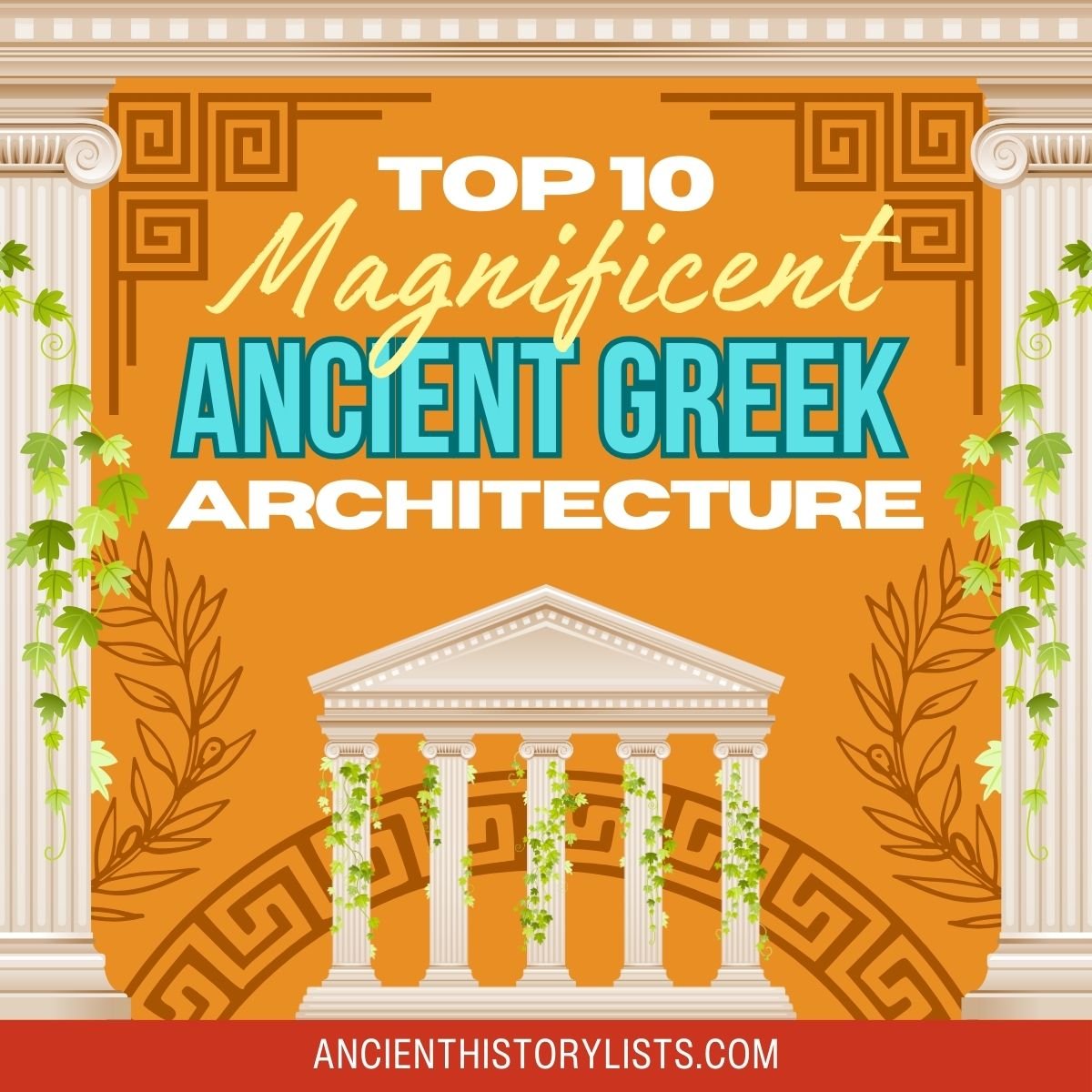
The simplicity, harmony, and perspective in Greek architecture was the foundation of Roman architecture as well. Ancient Greek architects strove for excellence and precision which indeed are the hallmarks of Greek art.
For more insight into this amazing style of architecture, read on for the top 10 best ancient Greek structures:
1. Temple of Olympian Zeus, Athens
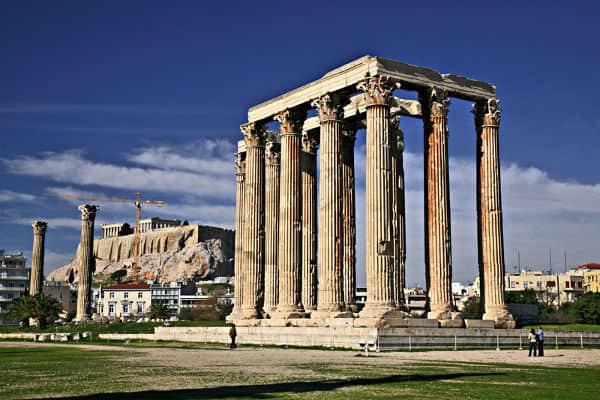
The Temple of Olympian Zeus was dedicated to “Olympian” Zeus. It’s also known as the Olympieion or Columns of the Olympian Zeus. It is a former colossal temple at the center of the Greek capital Athens. The building of the Temple began in the 6th Century by Peisistratos but work was stopped for unknown reasons. It was dompleted under the reign of the Roman Emperor Hadrian in 131 AD, 638 years after the project had begun.
2. Parthenon, Acropolis

One of the most influential buildings in Greek history, the Parthenon, stands on top of the citadel of the Acropolis. It was dedicated to the goddess of wisdom and patron of the Athenians, Athena.
The Parthenon was initially built as a celebration and thanks to the gods for the Hellenic victory over the Persians, but it also stands as an enduring symbol of Athenian democracy, ancient Greece, and Western civilization. It has served many roles over time, from a church dedicated to the Virgin Mary in the final decade of the sixth century to a mosque after the Ottoman conquest in the early 1460s.
The construction of this building began in 447 BC when the Athenian Empire was at its height. Considered the most significant surviving building of ancient Greece, the Parthenon is said to be the pinnacle of the Doric order. Its sculptures and artwork belong to the high end of Greek art.
The Parthenon was the replacement for the pre-Parthenon, an older temple of Athena which was possibly destroyed in 480 BC during the Persian invasion. Furthermore, like other Greek temples, it also served as the city’s treasury.
3. Odeon of Herodes Atticus, Acropolis
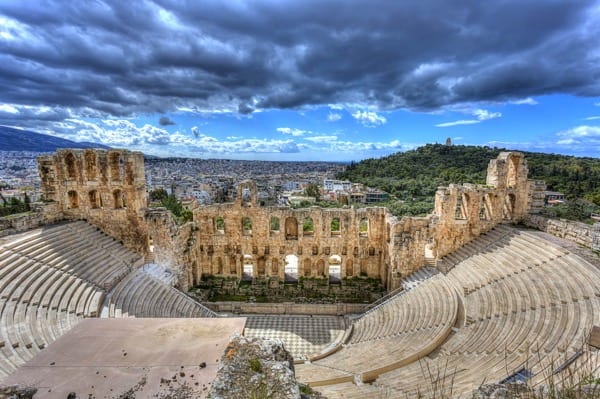
Since ancient times, the theater has been a significant part of Greek culture. The Odeon of Herodes Atticus is a stone theater structure on the southwest slope of the Acropolis in Athens, Greece. The Athenian magnate Herodes Atticus built the structure in memory of his wife, Aspasia Annia Regilla. It was a steep-sided theater which had a three-story front wall and a wooden roof made of expensive Lebanese cedar.
The theater played host to huge music concerts and had a capacity of 5,000. It regained its former glory in the 1950s when the stage and seating areas were rebuilt using Pentelic marble. The place has been the venue for a variety of Greek as well as international performances.
4. Temple of Hera, Olympia
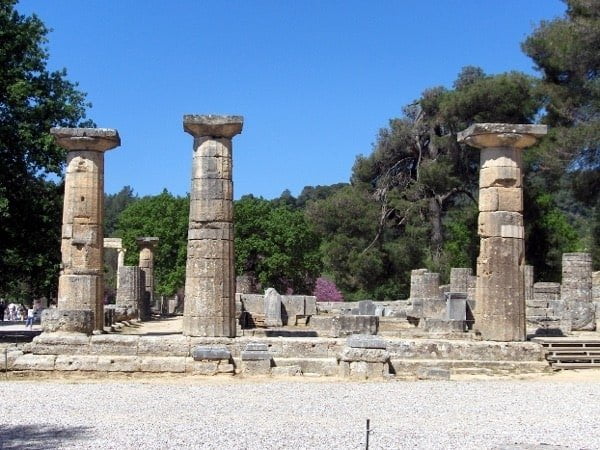
The ancient Archaic Greek temple, dedicated to the queen of the Greek goddesses, Hera, was built in 590 BC. The temple was initially believed to have been constructed from wood which was later replaced by stone. One of the oldest temples in Greece, it was solely dedicated to Hera with another temple to Zeus built nearby.
Built following the aesthetics of Doric architecture, the temple had 16 columns. The beautiful House of Hera was destroyed by an earthquake in the fourth century AD. During the excavation process on the site of the temple, a marble head of Hera was discovered along with a statue of Hermes by the sculptor Praxiteles. The statue now is housed in the archaeological museum of Olympia.
Furthermore, it is at the altar of the Temple of Hera that the Olympic flame is lit and taken to all parts of the world during the Olympic Games, the ruins thus becoming a symbol for the world’s largest games. The temple, close to the stadium, was protected by a terrace wall.
Historians say that the original temple was probably comprised of a room and a corridor, to which other things were slowly added. Under Roman control, the temple was made into a sort of museum to house precious treasure. While the lower part was made of limestone, the upper part was made of mud brick and terracotta tiles were also used. The entire structure was then made up of three rooms, two of which contained the statues of Zeus and Hera.
5. Temple of Artemis, Corfu
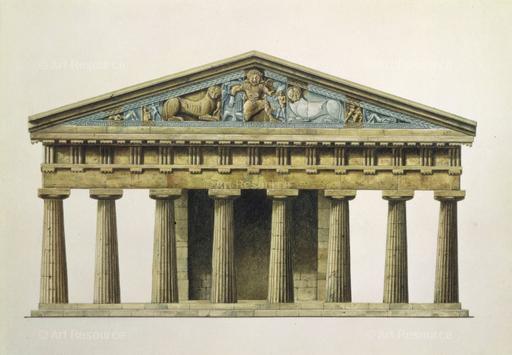
The temple was built in the ancient city of Korkyra on Corfu which is in the suburbs of the modern-day city of Garitsa. It was the first to be constructed from stone in the Doric style. Built in 580 BC, the temple measured 49m by 23.46m and was the biggest temple of its time.
From examples found in the temple ruins, it can be seen that the metope of the temple was decorated with carvings of Achilles and Memnon. Its magnificence and authenticity have made it a landmark in ancient Greek architecture. The temple is also counted among the 150 masterpieces of Western architecture.
The front and back of the temple comprised of two pediments, out of which only the western one has survived in good condition, while the eastern pediment is in fragments. The pediments were identical, decorated with mythical figures and sculpted in high relief.
This temple was probably the first-known example of a decorated pediment in Greece. According to the New York Times, the pediments have been described as the “finest example of Archaic temple sculpture extant.” The temple’s construction is said to have also influenced the design of an old sanctuary structure found at St. Omobono in Italy.
6. The Great Theater of Epidaurus
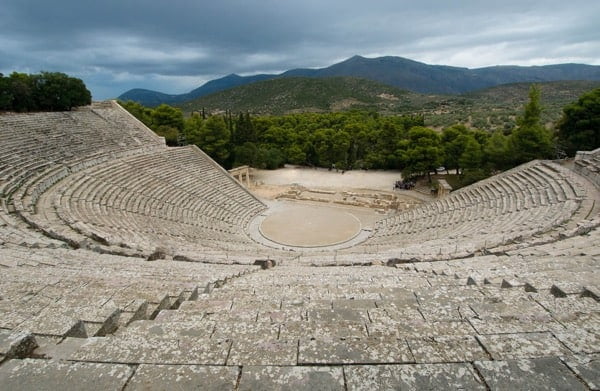
In terms of acoustics and aesthetics, this ancient theater is believed to be the perfect theater of all time, containing an auditorium, a stage building, and an orchestral area. According to the Greek traveler and geographer, Pausanias, Polykleitos the Younger was behind the construction of this beautiful symmetrical theater.
The theater was large enough to provide seating for 13,000 to 14,000 people. It not only hosted singing, music, and dramatic games but also included the worship of the god of medicine, Asclepius. The place was therefore used to heal patients since it was believed that witnessing a staged drama had a positive effect on both physical and mental health.
Like many other Greek theaters, it was not modified during the Roman era, and even today it retains a distinctively Hellenistic feel. In 1955, an annual event for the presentation of ancient drama was established called the Epidaurus Festival which still takes place during the summer months every year.
7. Temple of Apollo, Delphi
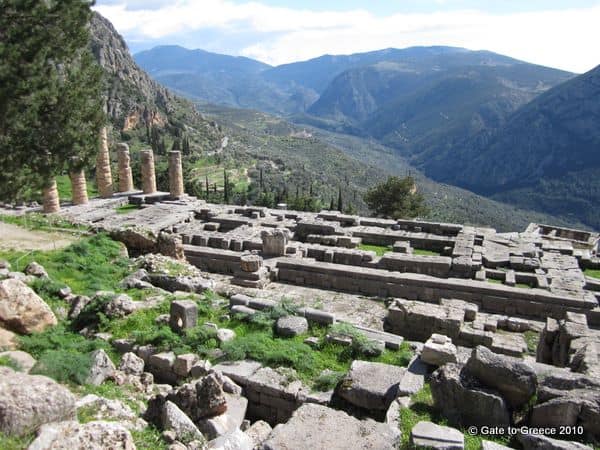
In the heyday of Delphi, the Temple of Apollo was the most prominent structure ever built, and its ruins date back to the fourth century BC. It was an imposing structure of the Doric order and it underwent many turbulent incarnations before falling into ruin.
The Temple of Apollo at Delphi was first built by two prominent architects Trophonios and Agamedes during the seventh century BC. It caught on fire during the sixth century after which it was rebuilt and given the name of the Temple of Alcmeonidae in honor of the noble Athenian family who took on its reconstruction with funds donated from all over Greece. The temple had six columns in the front and 15 at the sides.
Unfortunately, this temple was again destroyed in 373 BC by an earthquake and in 330 BC was rebuilt for the third time. The Corinthian architects Spintharos, Xenodoros, and Agathon oversaw its construction. The beautiful sculptures that embellish its pediment were the work of Athenian sculptors Praxis and Androsthenes. Though very little is known about the interior, the temple’s foundations include several porous stone and limestone Doric columns.
8. Stoa of Attalos, Agora
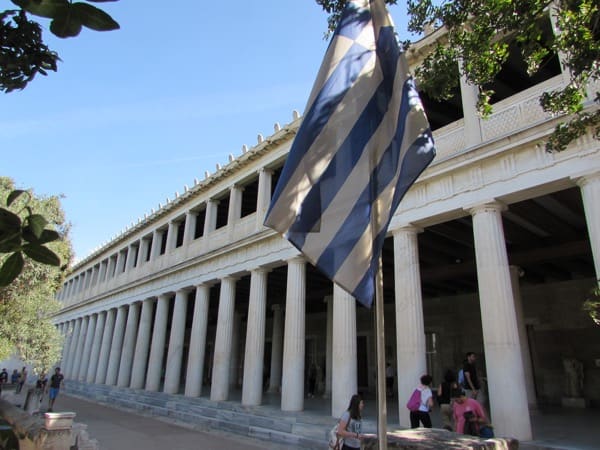
The architectural marvel, the Stoa of Attalos, was constructed as a gift to Athens in return for the education that Attalos received there. It was built by King Attalos II of Pergamon who ruled between 159 BC and 138 BC. Belonging to the Hellenistic era, the Stoa of Attalos was more elaborate and larger than the earlier buildings of ancient Athens.
Measuring 115 by 20 meters (377 by 66 feet), it was built from Pentelic marble and limestone. The building is a skillful work combining various architectural orders. The Doric order, which undoubtedly dominated Greek architecture, was used on the ground floor for the exterior colonnade and was combined with Ionic styling for the inner part of the colonnade.
The exterior colonnade on the first floor was Ionic and the interior was Pergamene. Each story comprised 21 rooms lining the western wall and two corridors. Stairs led up to the second story at each end of the stoa.
Destroyed by the Germanic tribe, the Heruli, in 267, its remains became a fortification wall until it was fully reconstructed between 1952 and 1956.
9. Temple of Hephaestus, Agora
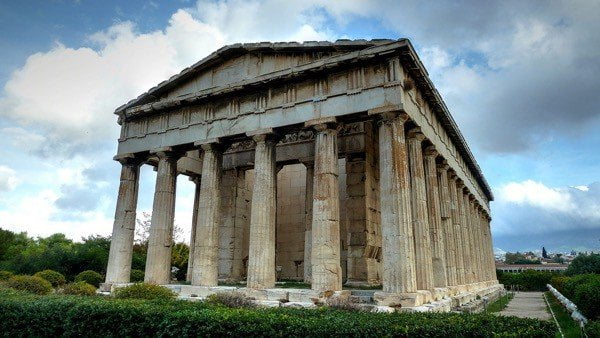
A work of Doric and Classical architecture, the Temple of Hephaestus is a well-preserved ancient Greek temple. Surviving the ravages of time, it stands just as it was built in 415 BC. Constructed two years before the Parthenon, the temple overlooks the city of Agora. It was dedicated to the god of craftsmanship, metal-working, and fire, Hephaestus, and was also called Theseum and served as a shrine dedicated to the hero Theseus.
The building is made of both Parian and Pentelic marble. The dimensions of the temple from north to south are 13.708m and east to west, 31.776m. It has six columns lying from east to west (the shorter side) and 13 columns from north to south (the longer side). The four columns at the corners are counted twice.
The temple has served various different roles. From the seventh century to the year 1834, it served as the Greek Orthodox Church of St. George Akamas. In the early 19th century, this temple-turned-church became a burial place for many Protestants and those who gave up their lives during the Greek War of Independence in 1821. In the 1930s it became a museum and since then has been restored to its original Greek glory.
10. Erechtheion, Acropolis
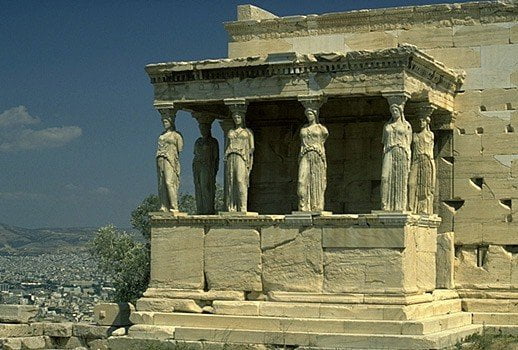
This temple was built between 421 and 406 BC by the great architect Mnesicles. The temple got its name from a shrine dedicated to the Greek hero Erichthonius, who was mentioned in Homer’s Iliad as a great king and ruler of Athens. It is believed that he is buried nearby. Phidias, who also worked on the Parthenon, was employed by Pericles as the sculptor and mason for this great project.
The ancient temple is said to have replaced the Peisistratid temple which was situated in Athena Polis and was destroyed in 480 BC by the Persians. The temple was located on a hill and was built from the marble taken from Mt. Pentelikon and black marble from Eleusis. It had carved doorways and beautifully decorated columns.
Conclusion
These wonders of Greek architecture have dominated our view of ancient Greece as their beauty and compelling history can be seen by visitors even today. The ancient Greeks were considered as the cradle of civilization with art at the heart of their accomplishments. Though most of their historic buildings have fallen into ruin, these ruins continue to speak of their great importance.
This is cool and #8 looks like its in perfect shape! Whoever made this good job!
these are some of the most beautiful buildings i’ve ever seen , thes all look like the are perfectly standing , i love all of these